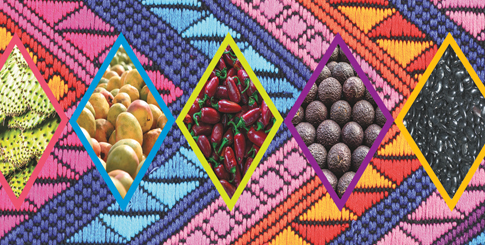Many consumer media outlets over the past several years have labeled a range of healthy food items as “superfoods.” The moniker, while it has little scientific support, tends to add consumer interest and boost purchases and the fresh produce category has been one of the main beneficiaries of this trend.
While the best-known superfoods are arguably berries and dark greens such as spinach and kale, a wide range of other commodities—many with roots in Latin America and popular in Hispanic cuisine—have been associated with the superfood label as well.
From papaya and purslane to chile peppers and lucuma, these items present an opportunity to increase sales in the U.S. Hispanic market by reinforcing a pro-health message.
Mainstream and More
According to Mary Ostlund, marketing director at Brooks Tropicals, LLC in Homestead, FL (near Miami), the continuing growth of the U.S.’s His-panic population in many areas “has been essential to the introduction of many tropicals to the produce aisle of every grocery store.”
In turn, due to escalating demand, retailers have sought out new or exotic items to fill shelves and displays. Brooks says Asian populations are also driving sales, as tropicals are grown in climates native to both Hispanics and Asians.
Many Hispanic-origin superfoods have gone mainstream; examples include mangos, avocados, chile peppers, and papayas. Ostlund believes commodities such as starfruit, red guava, dragonfruit, and passionfruit are on the path toward general-market status, while others, such as jackfruit and sapodilla, are still firmly in the specialty category.
Don Hugo Produce, Inc., an importer and wholesaler of Mexican produce in Edinburg, TX, sells the perennially popular avocados, cilantro, and hot peppers, as well as commodities still on the specialty end of the spectrum, such as verdolagas (sometimes called ‘Mexican parsley’ or purslane), nopalitos (cactus leaves or pads), and tunas (cactus pears).
“A healthy diet is one reason some of these items have seen an increase in consumption,” explains Sam De Los Santos, in sales. “Another reason is Hispanic cuisine has become more mainstream.”
Lance Jungmeyer, president of the Fresh Produce Association of the Americas in Nogales, AZ, agrees with De Los Santos, noting Mexican is even recognized by the United Nations as one of the world’s most popular cuisines. Further, he notes, “Hot peppers and avocados continue to drive foodservice dining trends in the United States. Mexico is the key source for these items,” he says, “and the industry continues to increase production to meet demand.”
Health and Messages Resonate
It should be noted that the term ‘superfoods’ does not have a universally agreed-upon meaning, nor is there much undisputed scientific data to back up many of the claims.



